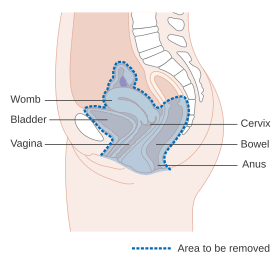| Pelvic exenteration | |
|---|---|
 Diagram showing the area removed in a pelvic exenteration in a female | |
| Other names | Pelvic evisceration |
| Specialty | Surgical oncology |
| ICD-9-CM | 68.8 |
| MeSH | D010385 |
Pelvic exenteration (or pelvic evisceration) is a radical surgical treatment that removes all organs from a person's pelvic cavity. It is used to treat certain advanced or recurrent cancers. The urinary bladder, urethra, rectum, and anus are removed. In women, the vagina, cervix, uterus, Fallopian tubes, ovaries and, in some cases, the vulva are removed. In men, the prostate is removed. The procedure leaves the person with a permanent colostomy and urinary diversion.
Pelvic exenteration often leads to complications, such as infection, kidney damage, embolism, perineal hernia, and problems with the stomas created. However, it increases 5-year survival rate from certain cancers. The procedure was first described by Alexander Brunschwig in 1948.